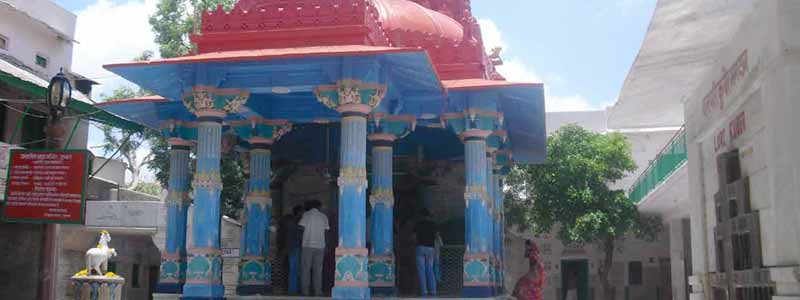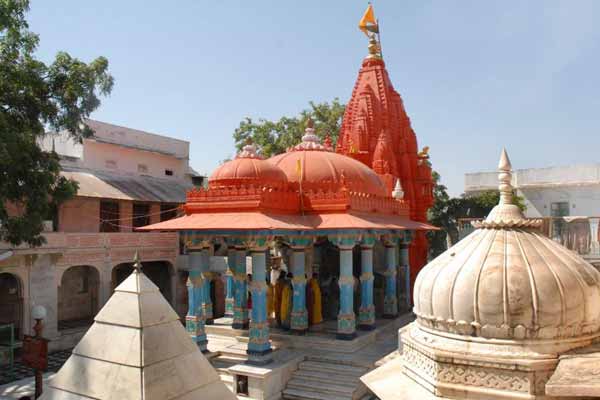Brahma Temple in Pushkar is one of Hindu religion’s most revered holy places. Devotees visit Pushkar during the year because of its significance. The Brahma temple in Pushkar is the subject of many legends. One of them is the legend of Brahma slaying a demon named Vajranabha who attempted to murder his children. He killed him with his knife, the blue lotus flower, because he was enraged.
The temple is built of marble and stone stabs. The red-colored shikara, which also has a hamsa bird motif, is a distinguishing feature of the temple. The temple’s entrance is adorned with pillared canopies. The mandapa refers to the temple’s outside hall, while the garbha griha refers to the temple’s interior. Thousands of silver coins are inlaid on the temple’s interior walls which the devotees have inscribed their names as a token of their offering to Lord Brahma Temple in Pushkar You’ll also find a silver turtle displayed on the temple’s marble floors.
The chaumurti, or central image of Brahma, is a massive image that adorns the temple’s garbhagriha. The image of Gayatri sits on the left side of Brahma’s idol, while the image of Savitri sits on the right. The temple’s walls are adorned with beautiful depictions of peacocks and Sarasvati’s mount. This Hindu holy temple is visited by a large number of devotees who travel from all over the world to give their prayers.

Legend of Brahma Temple
The petals of this flower dropped to the ground after the battle, and a spring of water appeared nearby. Pushkar Lake, or Pushkar Sarovar, was later named after this spring. The temple is within walking distance of the Brahma Temple.
Lord Brahma wanted to perform a yajna in Pushkar, but it would be incomplete if his wife Savitri was not present. Lord Brahma requested permission from Lord Indra to find a new wife so that his yajna could be completed. As a result of this appeal, the goddess Gayatri appeared and took part in the yajna as Brahma‘s wife.
Goddess Savitri was furious when she learned of this. She cursed Brahma, saying that the world would forget about him as a deity, and that he would be worshipped only in Brahma Temple in Pushkar.

History of Brahma Temple in Pushkar
According to the Hindu scripture Padma Purana, Lord Brahma once met a demon called Vajranabha who was murdering and torturing people. The Lord, seeing such heinousness, slayed the demon with a lotus flower (his special weapon). Some petals from the lotus flower drop to the ground in three positions when doing so. Three holy lakes were formed as a result of this, which are now known as the Jyestha Pushkar, Madhya Pushkar, and Kanishta Pushkar in modern times, Brahma Temple in Pushkar.
When the Lord came to earth later, he began the preparations for a yajna (fire sacrifice) at the Jyestha Pushkar Lake. Lord Brahma built a chain of hills around him so that he could perform the yajna without being disrupted by the demons. However, his wife Savitri was unable to attend the Yajna, causing the proceedings to be disrupted.
Lord Brahma then demanded that Lord Indra give him a suitable consort to finish the Yajna. Savitri arrived when a Gujar’s daughter, Gayatri, was finally sent to sit next to Brahma as his wife. She cursed Brahma, saying that the Lord would never be revered by anyone. She later only allowed him to worship in Pushkar. This made Pushkar’s Brahma temple the most appropriate place to worship the Lord.
Architecture of Brahma Temple
The famous Brahma temple in Pushkar is an entirely marble structure with temple architecture in the Southern style. The temple’s entrance, which is surrounded by pillared canopies and is reached by marble steps, is built on a raised platform.
The Mandapa, or pillared outdoor space, is reached after passing through the entrance. The sanctum sanctorum is located near the Mandapa (Garbhagriha). The statue of Lord Brahma, sitting in a cross-legged pose, stands in the centre of the Garbhagriha. The Lord of Preservation (Vishnu), glided Garuda (eagle man), and Dvarapalas are also depicted in the Pushkar Brahma temple’s interiors (gate-keepers)
On the mount of the temple, a red coloured spire (shikara) can be seen from the outside. Along with this, there’s a Hamsa (goose or swan) symbol to add to the exterior’s charm.
Best Time To Visit Pushkar – Brahma Temple
Pushkar is a lovely town surrounded on three sides by hills and surrounded on the fourth side by sand dunes. In the glistening winter sun set against the rippling, silvery waters of the Pushkar Lake, the fascinating whitish blue temples lend an air of serenity. The best time to visit Pushkar is in the winter, when temperatures range from 8°C to 22°C, making it nice to be outside.
Pushkar in summer – From April till June
Exploring Pushkar during the summer might not be a good idea, as the city has a traditional desert-style hot climate. The maximum temperature will exceed 45°C, with a minimum of around 25°C. Though hotels will offer discounts, if you intend to visit Pushkar during this period, bring an umbrella and sunscreen lotion with you.
Pushkar in Monsoon – From July till September
The monsoon arrives in Pushkar in the month of July and lasts until September. The town receives an average amount of rainfall, and the weather becomes hot and humid. Though the crowds are lighter at this time of year, if you don’t mind the occasional storm, Pushkar is worth a visit..
Pushkar in winter – From October till March
Pushkar is best visited during the winter months of October to March, when the good weather makes sightseeing and shopping enjoyable activities. The temperature varies from 8 to 22 degrees Celsius at this time of year. At this time of year, devotees and visitors alike flock to Brahma Temple in Pushkar.
How To Reach Brahma Temple in Pushkar
Pushkar, in the state of Rajasthan, is 14 kilometres from Ajmer. To get to this pilgrimage city, one may take one of the following routes:
By Rail: A rail journey is one of the easiest ways to get to Pushkar. There is no railway station in Pushkar. However, there is a railway link between Ajmer and Pushkar, which is just 15 kilometres away. Ajmer railway station has daily trains from all of Rajasthan’s and India’s major cities.
By Air: Pushkar does not have its own airport. If you choose to fly by plane, the closest airport is Sanganer Airport in Jaipur. The airport has excellent connectivity to India’s major cities, including New Delhi, Mumbai, and Kolkata. Pushkar is 142 kilometres from Jaipur, which can be reached by bus or hired taxi/cab.
By Road: If you’re travelling by car, the major highways and national highways that lead to Rajasthan are your best bet. Pushkar has a good road system that connects it to Jaipur, Jodhpur, Delhi, and Bikaner.
The journey from Jaipur to Pushkar took about 3 hours; however, be aware that the roads in this part of India can be dusty and bumpy at best, chaotic and hazardous at worst! We had a couple of close calls with other cars and had to just close our eyes and hope for the best!
Timings of Brahma Temple
The temple is open for worship from 6:30 a.m. to 8:30 p.m. in the winter and 6:00 a.m. to 9:00 p.m. in the summer, with a break in the afternoon from 1:30 p.m. to 3:00 p.m. Sandhya arati is held in the evening about 40 minutes after sunset, Ratri Shayan arati (night-sleep arati) is held about 5 hours after sunset, and Mangala arati is held in the morning, about 2 hours before sunrise.
Winter Timing – 6:30 AM to 8:30 PM
Summer Timing – 6:00 AM to 9:00 PM
The temple remains close in afternoon time between 1:30 pm to 3:00 pm
